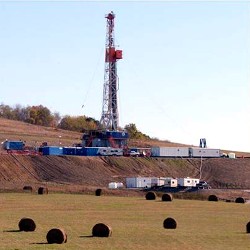University of Oklahoma researchers in Norman are developing a new simulator for shale gas reservoirs to provide oil and gas companies with a tool for managing production and choosing drilling locations. The three-year project is supported with $1,053,778 from the group Research for Partnership to Secure Energy for America plus an additional $250,000 in matching funds from a consortium of six oil and gas producing companies.
Engineering professors Richard Sigal, Faruk Civan, and Deepak Devegowda are building the simulator. One of their project’s goals is to better determine and model the disposition of water from hydraulic fracturing, a method used frequently to open up the reservoir for pumping out the gas.
Conventional natural gas reservoir simulators, as Sigal notes, are not suited for shale gas reservoirs. “Current commercial simulators do not successfully predict the amount of water produced,” says Sigal. “Researchers need to model the deposition of this water to better understand the reservoir and address concerns the effects this water can have on shallow aquifers.”
The simulator team plans to factor in new developments in geology and physics. University colleagues have found two kinds of pore space in the rocks. Besides the inorganic pore space where one would expect to find gas, they discovered pores the size of nanometers — one billionth of a meter — in the organic portion of the rock. Sigal says this discovery needs to be incorporated into the simulator design.
The physics of the fluid flow and storage are different for the organic and inorganic portions of shale gas reserves. To better account for these differences, researchers working with artificial nanomaterials have developed new equations for gas transport that will need to be included in the simulator. The Oklahoma team also plans to include findings on the different capillary action in shale gas reserves from differing transport rates of gas and water, as well as the varying rates of permeability caused by the much smaller pore sizes.
- More Research Urged on Marcellus Drilling Impact
- University, Oil Company Partner on Infrastructure Corrosion
* * *


 RSS - Posts
RSS - Posts
[…] This post was mentioned on Twitter by Alltop Science. Alltop Science said: University of Oklahoma to Develop Shale Gas Simulator http://bit.ly/g9awOx Science.alltop […]